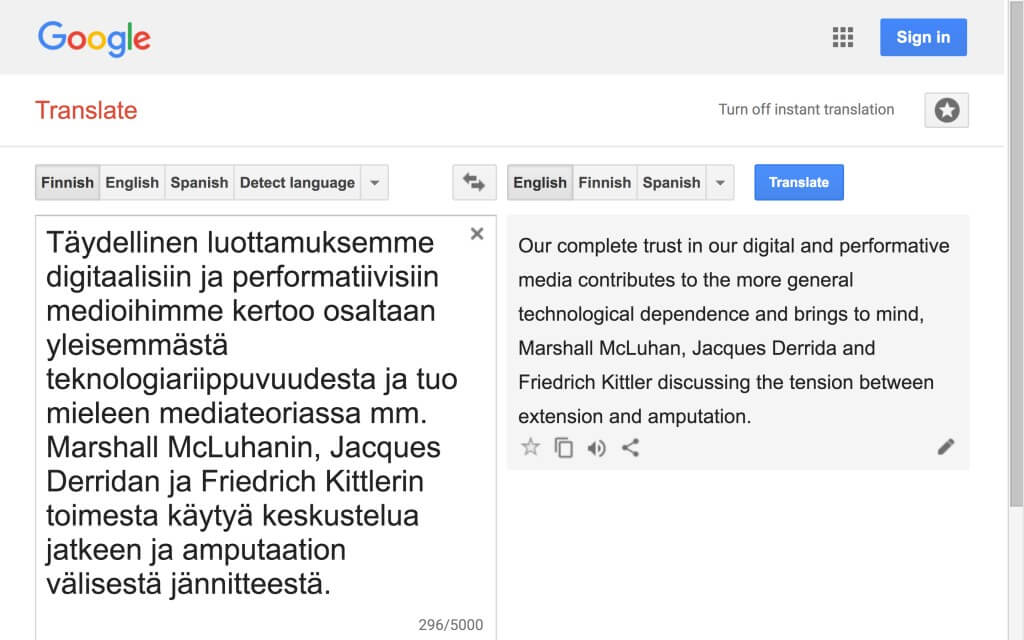1.12 Fragment 12
- Fragment 12, adapted from Hayles passage 10
Video 1.12.1 EN Sources referenced in Video 1.12.1 EN: Coffey n.d., Huopaniemi 2007
From Symptomatic to Surface Reading
In order to acquire tools for the critical examination of my reading of DAR’s adaptation, I will close the Prologue by addressing symptomatic reading, a topic Hayles touches upon in her examination of different forms of reading (Hayles 2012, 59; see also 2.2). As video 1.12.1 demonstrates, I have a tendency to search for symptoms in DAR’s adaptation and approach it through them. In video 1.12.1, the symptom I take aim at is DAR’s lack of in-depth reading in the subject they deal with.
Hayles deals with symptomatic reading in the third chapter of her book, “How We Read,” where she writes of the “heterogeneity of close reading techniques” (Hayles 2012, 59). Of these techniques, one of the most dominant in recent decades (at least in the US) has been symptomatic reading (Best & Marcus 2009, 1–21). The foundation for this technique has, in large part, been laid by Fredric Jameson’s influential book The Political Unconscious (1981).
In Hayles’s reading of Jameson, a text is an excuse for “subtextual ideological formations” (Hayles 2012, 59). The duty of the valiant critic is to yank the ideology of the text into daylight in full, so that it can be resisted. Listing characteristics of the text that deserve special attention, such as ambiguous words, is according to Hayles typical of symptomatic reading, as is demonstrating inconsistencies “between what a text says and what it does” (Johnson according to Hayles 2012, 59).
Researchers carrying out symptomatic reading search for evidence of the subsurface ideology of the text in such ambiguities. Similarly, I zero in on DAR’s word choices in both languages and other details in an attempt to disclose what is behind them. What seems to trigger this inspection is a suspicion concerning DAR’s motives for adapting Hayles, even a lack of trust in their desire to carry out research in earnest.
However, as I express in video 1.12.1, in the subsequent parts of this thesis I would like to refrain from my usual reading strategy and look for alternatives—or at least complement my symptomatic reading with other techniques. Perhaps my desire springs from an experience similar to that of researchers in the US, who, according to Hayles, no longer find symptomatic reading a useful practice (Hayles 2012, 59). Symptomatic reading is seen to lead to formulaic, predictable conclusions rather than convincing results.
Surface reading, which examines the undisguised messages of a text instead of searching for its hidden clues, has been proposed as an alternative for symptomatic reading, along with other reading strategies (Best & Marcus 2009, 1–21). In her conclusion, Hayles refers to “reading aimed at appreciation and articulation of the text’s aesthetic value” and “a variety of other reading strategies focusing on affect, pleasure, and cultural value” (Hayles 2012, 59). As DAR’s adaptation is not a literary text (although it is created in a similar manner as many literary texts), I find it unreasonable to criticize myself for neglecting its aesthetic value.
However, with good reason I can ask, do I put enough effort into understanding and expressing the distinctiveness of DAR’s text. Even more so I can ask, do “affects, pleasure, and (the) cultural value” of the text receive far too little attention in my responses to the fragments of DAR’s adaptation. What could surface reading mean in this context? How could I concentrate on the immediate, observable layer of DAR’s adaptation rather than attempt to dig up its (supposedly) questionable ideological substructures? Does such a surface without a substructure even exist?
The main consideration in this context is, moving closer to the artistic parts of the research, what kind of reading strategy continues to produce insights and views on the subject matter at hand. If my symptomatic reading no longer does so, what purpose could it possibly serve? In any case, this self-critical note opens a new meta-level question that will be resolved in the course of this thesis.
In this commentary, what is ultimately at stake is responding to DAR’s Hayles-adaptation associatively and informatively—and in a spirit of (mutual) respect. Another close reading strategy that could prove useful is interrogative reading, initiated by Michael Vanden Heuvel and developed in Finland by Juha-Pekka Hotinen (Vanden Heuvel 1993, 159–166; Hotinen 2002, 207–227). An openly questioning, reflective, and associative approach to text such as this, or then a form of surface reading, could assist in taking DAR at their word.

